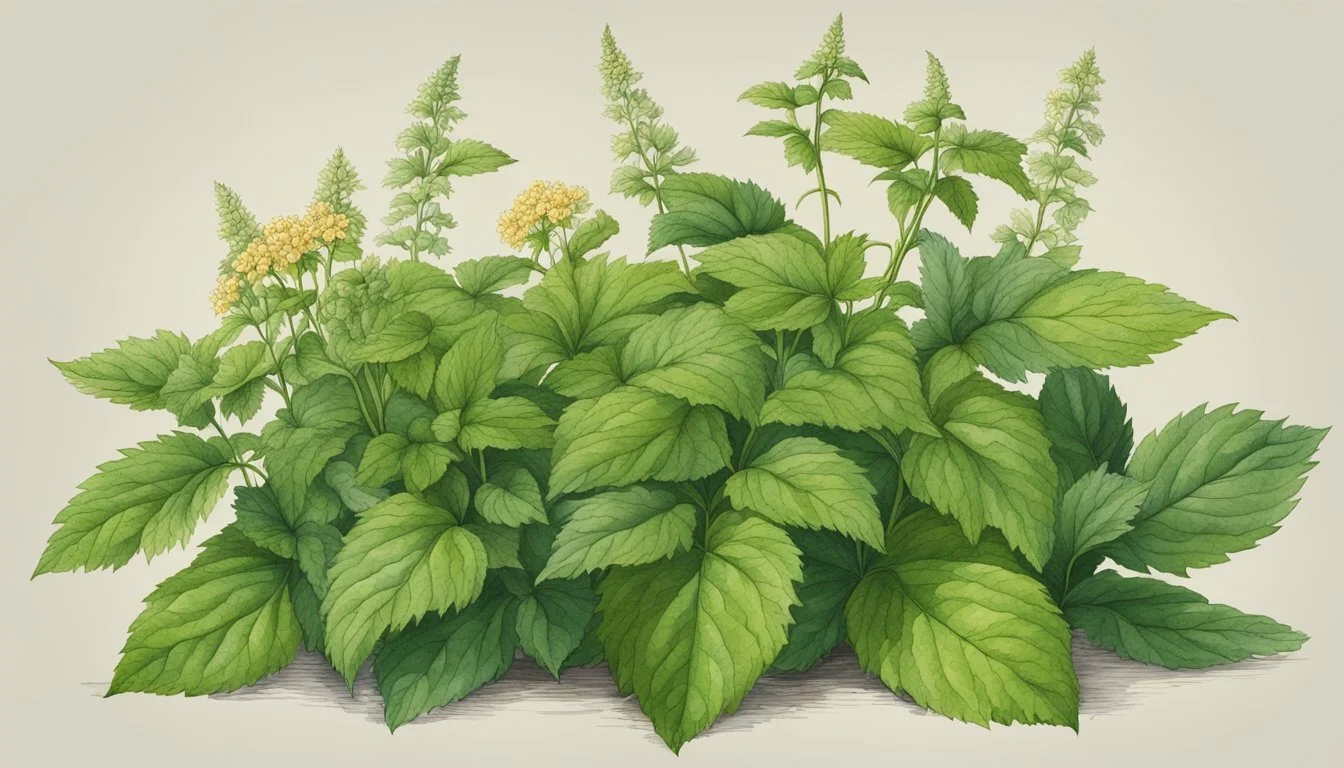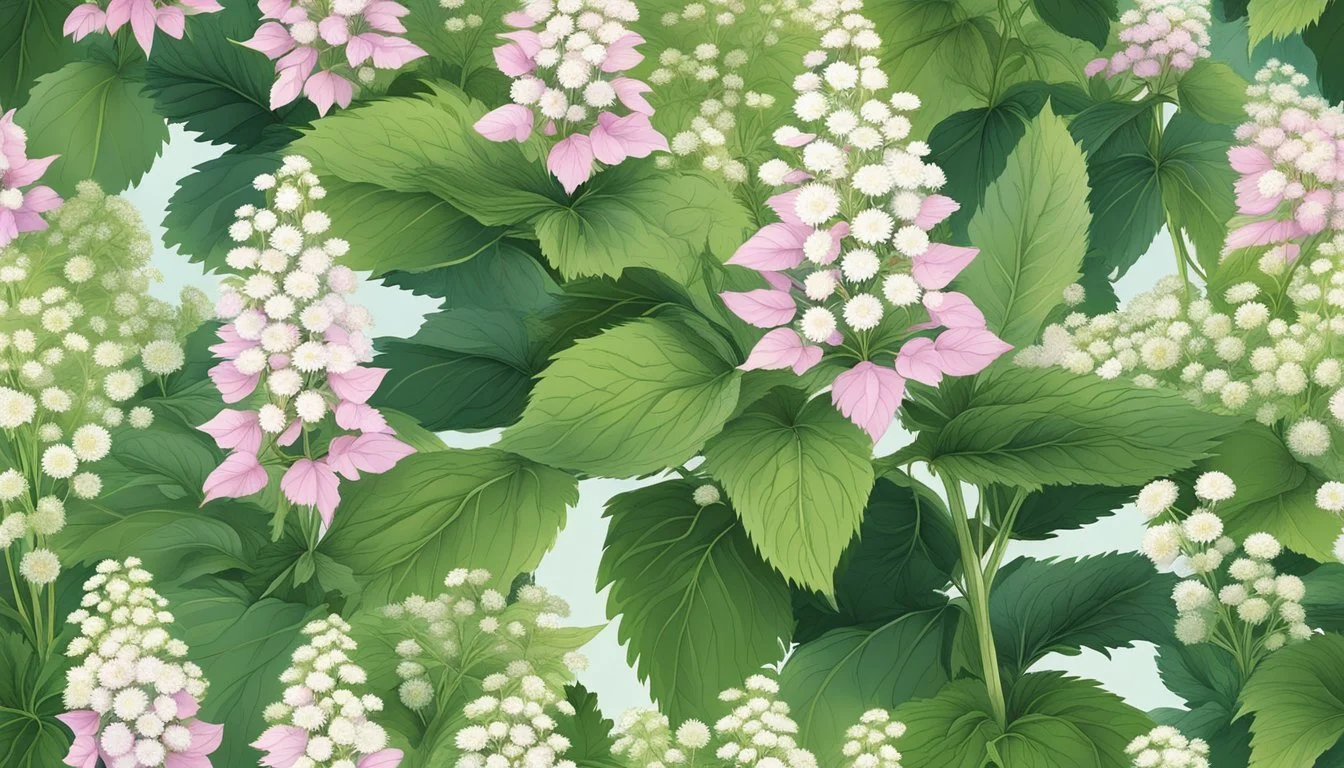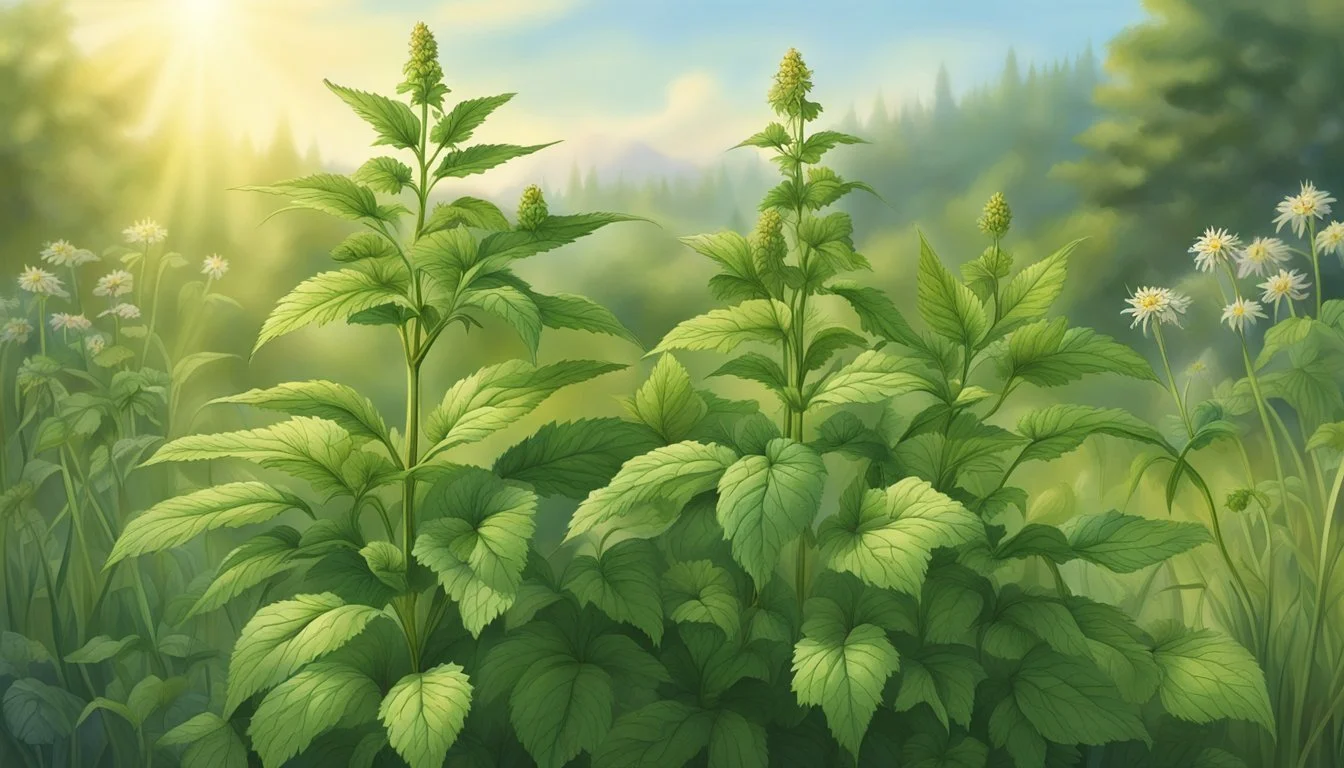Nourishing Nettle
Unveiling the Iron Powerhouse with a Healing Past
Nettle, scientifically known as Urtica dioica, is an herbaceous perennial plant with a rich history of medicinal use dating back to ancient Greece. Renowned for its high iron content, nettle is often considered a nourishing staple in herbal medicine and nutrition. The plant's leaves are packed with essential nutrients, including vitamins A and C, potassium, manganese, and calcium. The iron content, in particular, is notable for its role in combating anemia and boosting overall energy levels. Traditionally, nettle has been employed to modulate the body's inflammatory pathways, offering support for various health concerns, from upper respiratory conditions to skin ailments.
Historically, nettle's versatility extended beyond its medicinal uses, as it was also valued for its role in fiber production. However, it is the iron-rich nature of nettle that has solidified its reputation as a beneficial tonic. A cup of nettle tea, steeped from the leaves, acts as a stimulant, leaving one feeling revitalized, likely due to the herb's nutritive properties. While nettles are often overlooked due to their stinging hairs, which can cause discomfort upon contact, these same plants have been cultivated and transformed into nourishing remedies used across generations.
In contemporary wellness circles, nettle persists as a plant of interest for its potential health benefits. Its consumption in various forms, such as teas, soups, and even as a cooked green, promises to contribute vital nutrients that support overall health. The plant’s historical use is matched by modern research exploring nettle's role as a gentle detoxifying agent and its potential for supporting holistic wellbeing.
Nourishing Nettle has long been celebrated for its exceptional health benefits, serving as a nourishing powerhouse in traditional wellness practices. This remarkable herb has been revered for its potential to support overall well-being. When combined with goldenseal and frankincense and myrrh, Nourishing Nettle offers a holistic approach to promoting health, reflecting its enduring appeal in ancient and modern wellness traditions.
Furthermore, the addition of black seed oil, peppermint, and maca root further complements the nourishing potential of Nourishing Nettle, contributing to its reputation as a versatile and effective natural remedy. Additionally, the incorporation of aronia berries and moringa into wellness practices alongside Nourishing Nettle has expanded the spectrum of potential health benefits, underscoring the enduring appeal of this remarkable herb.
In conclusion, Nourishing Nettle continues to be celebrated for its nourishing properties, offering a natural solution for promoting well-being. Whether combined with goldenseal, frankincense and myrrh, black seed oil, peppermint, maca root, aronia berries, or moringa, Nourishing Nettle remains a symbol of health and vitality, embodying the rich heritage of natural health practices.
Understanding Nettle: Botany and Species
Nettle, particularly the species Urtica dioica, is a perennial plant known for its iron-rich composition and historical medicinal uses. This section explores the botanical aspects of nettle and provides details on its preferred habitat and cultivation practices.
Species Overview: Urtica Dioica
Urtica dioica, commonly known as stinging nettle, is a herbaceous perennial flowering plant that belongs to the Urticaceae family. It is distinguished by its heart-shaped leaves and the presence of tiny, stinging hairs on the stems and leaves. When touched, these hairs release substances that can cause a stinging sensation.
Key Attributes of Urtica Dioica:
Botanical Status: Perennial, herbaceous plant
Leaves: Heart-shaped with serrated edges
Stinging Hairs: Present on stems and leaves
Reproduction: Both by seeds and vegetatively through rhizomes
Nettle Habitat and Cultivation
Nettle thrives in temperate regions and is native to Europe, Asia, northern Africa, and western North America. Its habitat typically includes moist or damp, nutrient-rich soils that are either slightly acidic or neutral in pH. Optimal planting densities for fiber production range from 2 to 3 plants per square meter.
Cultivation Practices:
Planting Layout: 50 cm × 50 cm or 50 cm × 75 cm recommended
Soil Requirements: Moist, richly fertile, weakly acid or weakly basic
Habitat: Native to temperate regions across several continents
The plant supports a wide range of insects and holds ecological importance due to its defense mechanisms and nutritional offerings. In cultivation, prior crop selection and soil preparation are essential to optimize growth and productivity.
The Nutritional Profile of Nettle
Stinging nettle is not only known for its medicinal properties but is also a powerhouse of essential nutrients, including proteins, vitamins, minerals, and beneficial plant compounds. The section below dissects the varied nutritional components that make nettle a valuable addition to a health-conscious diet.
Macronutrients: Protein, Carbohydrates, and Fats
Protein: Nettle is a notable source of plant protein, an important macronutrient for body repair and enzyme functions.
Carbohydrates: The carbohydrate content in nettle primarily consists of simple sugars and dietary fiber.
Fats: While nettle contains low levels of fat, the present fatty acids are mostly unsaturated, which are considered beneficial for heart health.
Vitamins and Minerals in Nettle
Nettle is rich in a variety of micronutrients essential for maintaining good health:
Vitamins:
Vitamin A: Crucial for eye health and immune function.
Vitamin C: Known for its antioxidant properties and immune support.
Folic Acid (Vitamin B9): Vital for DNA synthesis and repair.
Minerals:
Iron: High in nettle, iron is fundamental for oxygen transport and the formation of red blood cells.
Calcium: Supports bone health and muscle function.
Potassium: Necessary for normal cell function, muscle contractions, and nerve signals.
Fiber and Amino Acid Contents
Fiber: Nettle leaves provide dietary fiber, which supports digestive health and can aid in cholesterol management.
Amino Acids: The plant is a source of amino acids, the building blocks of proteins, some of which are essential and must be obtained from the diet.
Health Benefits of Stinging Nettle
Stinging nettle has been recognized for its nutrient-rich profile and potential in addressing a variety of health concerns, ranging from iron deficiency to inflammatory conditions. This section delves into the specific health benefits associated with this traditional medicinal plant.
Supporting Hemoglobin and Oxygen Transport
Stinging nettle provides a rich source of iron, a critical component in the formation of hemoglobin. Iron is essential in the human body for facilitating the transport of oxygen to tissues. Incorporating nettle into one's diet may help address iron deficiency and consequently anemia, by aiding in the increase of red blood cell production.
Digestive Health and Detoxification
Nettle is valued in herbal medicine for its support of digestion and detoxification processes. Rich in nutrients and bioactive compounds such as flavonoids and phenolic compounds, it can promote healthy digestion and may aid in detoxifying the body, becoming a complementary option for treating ailments like gout or supporting lactation during postpartum recovery.
Nettle's Anti-Inflammatory Properties
The anti-inflammatory properties of stinging nettle stem largely from its array of flavonoids and phenolic compounds, which exhibit antioxidant activity. These substances can help reduce inflammation, offering therapeutic benefits for conditions influenced by inflammatory processes, potentially including certain forms of arthritis and skin concerns.
Potential in Cancer Prevention and Treatment
Research points to nettle possessing various compounds with potential in cancer prevention and treatment. This is attributed to its antioxidant activity, which can neutralize harmful free radicals and play a role in inhibiting cancerous cell growth. However, stinging nettle should be used as an adjunct to conventional medicine and not as a sole treatment for cancer.
Nettle in Cuisine: Preparation and Uses
Stinging nettle has made its way into culinary practices as a highly nutritious vegetable that can elevate dishes with its rich iron and nutrient content. From traditional soups to innovative culinary creations, nettle offers a distinctive flavor and an array of health benefits.
Cooking with Nettle: Soups and More
Nettle leaves are often used to prepare wholesome soups that are not only nourishing but also carry a delightful, earthy taste. Before cooking, nettles should be blanched to remove their sting, making them safe to eat. A simple nettle soup can be made by sautéing garlic and other vegetables like onions and carrots, then adding blanched nettles and stock, followed by pureeing for a smooth texture. The addition of herbs and a dollop of cream or cheese enhances the flavor profile, resulting in a comforting bowl of soup.
Simple Nettle Soup Recipe:
Sauté garlic and chopped vegetables
Add blanched nettle leaves
Pour in vegetable or chicken stock
Blend until smooth
Season with herbs
Serve with a swirl of cream or a sprinkle of cheese
Nettle as a Spinach Substitute
Nettle can substitute spinach in almost any recipe due to its similar texture and nutritional qualities. After blanching, nettle leaves can be incorporated into pasta dishes, omelets, and even as a pizza topping. One can combine nettles with olive oil, garlic, and cheese to create a vibrant, iron-rich pesto or use them in savory pastry fillings. Nettles also complement salads when used sparingly, providing a nutritious boost.
Using Nettle in Place of Spinach:
Pasta with nettle-herb pesto
Nettle-infused cheese omelet
Pizza topped with sautéed nettles and mushrooms
Savory pastries stuffed with nettle and feta
Innovative Nettle Delicacies
As a functional food, nettles are being innovatively used beyond traditional dishes. Ground nettle leaf powder serves as a protein supplement and can be added to bread dough, increasing the nutritional value significantly. This green powder enriches foods with fiber, calcium, copper, and iron. Creative chefs have ventured to make nettle-flavored ice creams and infusions, showcasing the versatility of this edible plant.
Creative Nettle-Enhanced Foods:
Nettle bread with increased nutritional value
Nettle-infused ice creams for a unique dessert experience
Nettle beverages as nutrient-rich refreshments
By incorporating stinging nettle into various recipes, one can enjoy the rich flavors and health benefits that this historical plant provides. Whether in a hearty soup or as an innovative twist to everyday dishes, nettle invites a new dimension to cooking with its nutrient-dense leaves.
Nettle Beyond Food: Other Applications
Stinging nettle, known for its nutritious value, also possesses a range of applications that extend far beyond its culinary uses.
Textile Fiber: Historically, nettle has been a source of fiber for producing textiles. The plant's long, strong fibers are conducive to creating a durable fabric with an appealing texture. These fibers are particularly prominent in the stem of the plant and, when processed correctly, can result in material suitable for clothing and other fabrics.
Crafting and Dyeing: The nettle plant's versatility is evident in crafts and dyeing. The leaves and stems can produce a variety of shades, such as green and yellow, depending on the mordant used. It is also utilized in folk traditions for making rope and other crafts where sturdy fibers are preferred.
Medicinal Properties: Nettle harnessed for its:
Bioactive Compounds: Research has indicated that stinging nettle is rich in biologically active compounds that could have anti-inflammatory properties.
Energetic Qualities: In traditional medicine, nettle is often associated with energetic benefits, possibly aiding in overall vitality.
Agricultural Use:
Fertilizer: The high nitrogen content in nettle makes it excellent for use as a natural fertilizer, contributing to the growth of other plants.
Functional Properties: Recent studies are exploring the potential functional properties of nettle in various applications, including its role in homeopathic remedies and holistic health practices.
In these many applications, nettle demonstrates its multifaceted nature—proving that it is more than just another edible plant but a resource with multiple traditional and potential modern uses.
Cultivation and Harvesting Tips
Nettle, a perennial plant with a rich history in herbal medicine, requires specific conditions to thrive and particular methods for safe harvesting. Knowing how to grow and harvest nettle not only ensures a bountiful yield but also maximizes the plant's nutritional and medicinal benefits.
Growing Nettle at Home
Starting the nettle plant at home involves planting 1-3 seeds in a container filled with high-quality potting soil. Seeds should be lightly covered with 1/4 inch of soil and kept moist to facilitate germination, which typically takes 10-14 days. Seedlings must be gradually exposed to outdoor conditions over a period of one week, a process known as hardening off, before being transplanted to the garden. Gardening enthusiasts should consider growing nettle as it is not only nutrient-rich but also a hardy perennial that can enhance the biodiversity of a garden.
Optimal Conditions for Healthy Nettle Plants
For healthy growth, nettle plants prefer:
Soil Type: Rich, moist, and fertile soil.
Lighting: Partial to full sun exposure.
Watering: Consistent moisture, especially in dry conditions.
These conditions allow the nettle to grow vigorously. Gardeners must avoid the use of pesticides as nettle attracts beneficial insects and supports the garden's ecosystem.
Harvesting Nettle Safely and Efficiently
When harvesting nettle, one should:
Wear gloves and long sleeves to prevent stings.
Use scissors or gardening shears to cut the top third of the plant, which is the most tender.
Harvest before the flowers appear, as this is when the leaves are most potent.
To maintain the plant and allow for continuous growth, it's best to harvest in cycles. Nettle should be processed shortly after harvesting for culinary use or dried and stored for herbal applications.
Conservation and Environmental Impact
Stinging nettle, with its rich historical significance in traditional medicine, thrives in nitrogen-rich habitats. Conservation of nettle is noteworthy because it indicates the health of the ecosystem. It serves as a gauge for soil fertility, often flourishing in areas abundant in nitrogen, which can be indicative of prior habitation or waste decomposition.
In terms of environmental impact, nettle can be a beneficial addition to agricultural systems. The plant's ability to prosper in various conditions makes it resilient to climate stressors. Its presence can reduce the need for chemical pesticides, as it hosts predators that feast on common pests.
Here's a brief overview of its ecological implications:
Habitat: Nettle supports biodiversity, offering habitat and nourishment to a variety of insects and wildlife.
Nitrogen: It acts as a bioindicator for nitrogen-rich soils, often pointing to environmentally degraded areas needing attention.
In traditional medicine, nettle has been utilized for its nutritional value, containing high levels of iron. It represents a sustainable option within plant-rich dietary patterns, contributing to both health promotion and environmental preservation.
The cultivation of nettle, especially within organic farming practices, eschews the reliance on synthetic fertilizers. Instead, nettle itself can be processed into plant-based fertilizers, establishing a symbiotic relationship within the ecosystem by recycling nutrients and minimizing waste.
The importance of nettle in conservation extends beyond its immediate uses to its role as an environmental steward, informing sustainable practices and land-use strategies.
Historical and Cultural Significance
Stinging nettle, or Urtica dioica, derives its etymology from the Latin word "uro", meaning "I burn", a reference to its well-known stinging properties. This perennial herbaceous plant boasts a rich history in traditional medicine, often utilized for its myriad therapeutic constituents, including its notable iron content.
In ancient societies, stinging nettle was widely recognized for its medicinal value. Varying cultures integrated it into healthcare practices, primarily for its anti-inflammatory and pain relieving effects. In addition to its medicinal applications, nettle held a prominent position in cultural heritage. For example, in Scotland during the 16th and 17th centuries, textiles made from nettle fibers were highly valued for household linens.
Nettle's nutrients, notably vitamins, minerals, and polyphenols, position it as a valuable component in both medicine and nutrition. These nourishing constituents have been the basis for its historical use in remedying ailments such as joint pain and skin conditions.
Region Use Case Europe Remedies, Textile Fiber Asia Nutritional, Medicinal Africa Traditional Medicine North America Dietary Supplement
As a testament to its global significance, every continent with traditional healing practices seems to have found a place for stinging nettle. Its historical narrative is not merely a tale of utility but also one of a cultural treasure, ingrained in the fabric of natural remedies passed down through generations.
Concluding Thoughts on Nettle
Stinging nettle has cemented its place not only in the annals of herbal medicine but also as a nourishing botanical powerhouse. Its rich iron content positions it as a remarkable plant for those looking to supplement their diet, particularly in cases of iron deficiency. Herbalists have long revered Urtica dioica, not only for its abundance in iron but also for its wealth of vitamins, minerals, and protein, making it a comprehensive dietary addition.
Nettle has been utilized for over two millennia, reflecting a deep-rooted belief in its medicinal properties. Every part of the plant—the seeds, leaves, and roots—plays a role in traditional healing practices. The following is a snapshot of nettle's contributions to health:
Nutritional Density: High levels of nutrients like flavonoids, fatty acids, and vitamins.
Iron Source: Recognized for being a digestible iron source in plant form.
Incorporating stinging nettle into one's diet or health regimen can be done through various means such as capsules, teas, infusions, or as cooked greens. The plant is also identified for its role in detoxification and is often recommended as part of a "spring cleaning" regimen for its blood cleansing properties.
Respect for stinging nettle stems from both its historical uses and its continuing relevance in today's health-conscious society. This resilient herb’s versatility and nutritional profile ensure that it continues to be a valuable ally in the field of herbal medicine and a nourishing nettle for those seeking natural wellness solutions.








